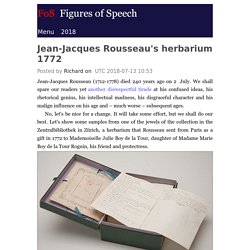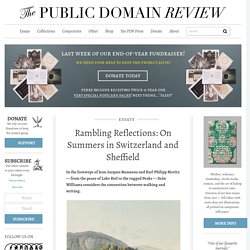

Jean-Jacques Rousseau's herbarium 1772. Jean-Jacques Rousseau (1712-1778) died 240 years ago on 2 July.

We shall spare our readers yet another disrespectful tirade at his confused ideas, his rhetorical genius, his intellectual madness, his disgraceful character and his malign influence on his age and – much worse – subsequent ages. No, let's be nice for a change. It will take some effort, but we shall do our best. Let's show some samples from one of the jewels of the collection in the Zentralbibliothek in Zürich, a herbarium that Rousseau sent from Paris as a gift in 1772 to Mademoiselle Julie Boy de la Tour, daughter of Madame Marie Boy de la Tour Roguin, his friend and protectress. Rousseau was a keen walker and plant collector: many of his strolls were intended as plant collecting forays. The images that follow are only a selection of the 211 pages in Julie's herbarium. Rousseau provided a seven-page list of plant names keyed to his specimens. Zentralbibliothek Zürich / Petit Herbier pour Mademoiselle Julie Boy-de-la-Tour. Herbier dit "de Jean-Jacques Rousseau"
"Je ne connais point d’étude au monde qui s’associe mieux à mes goûts naturels que celle des plantes", écrivait Jean-Jacques Rousseau (1712-1778) dans Les Confessions.

Il composa d’élégants petits herbiers qu’il offrait à des amies. Peu avant sa mort, le philosophe acquit une collection qui fut conditionnée en une série de 15 classeurs cartonnés rouges portant son nom. Cet herbier comporte 494 plantes dont la récolte est attribuée à Jean-Baptiste Fusée Aublet (1720-1778) pharmacien et botaniste, auteur de la première flore de la Guyane française. Les végétaux, fixés sur du papier notarié de récupération, proviennent de France métropolitaine et d’Espagne, mais aussi de Guyane. Un certain nombre d’échantillons sont des "types" (spécimens de référence pour les botanistes) car il existe une réelle convergence entre les dessins d’Aublet et les spécimens.
D’après Gérard Aymonin L’Herbier du Monde et L’Herbier du MuséumPour en savoir plus sur ces ouvrages. Rousseau/Aublet Herbarium online (MNHN) Jean Baptiste Christophore Fusée Aublet. Jean Baptiste Christophore Fusée Aublet[1] (November 4, 1720 – May 6, 1778) was a French pharmacist, botanist and one of the earliest botanical explorers in South America.[2] He was one of the first botanists to study ethnobotany in the Neotropics.[3] Born in Salon-de-Provence, Aublet left home early and traveled to Grenada, then a French colony, where he became an apothecary's assistant and learned about medicinal plants.[2] A year later he returned to France and continued his studies in natural history, chemistry, and pharmacology.

One of his mentors was Bernard de Jussieu, a French naturalist who would later help him with plant identification.[3] When Aublet returned to France in 1762, he was appointed to a position as the King's apothecary and botanist in French Guiana. He arrived at the colonial capital, Isle de Cayenne, in August 1762 and spent the next two years collecting plants and assembling a vast herbarium. References[edit] Further reading[edit] External links[edit]
Rousseau's "Delessert" herbarium Getty Images. Cook: Rousseau's anticipation of plant geography. Rousseau: On Summers in Switzerland and Sheffield. In the footsteps of Jean-Jacques Rousseau and Karl Philipp Moritz — from the peace of Lake Biel to the rugged Peaks — Seán Williams considers the connection between walking and writing.

In late summer and early autumn of 1765, Rousseau was on the run. He was always fleeing some sort of persecution: at times very real, and legal; at others perhaps more perceived, and highly personal. A restless existence, certainly, yet Rousseau’s last and most retrospective work tells of a life not of flights, escapes, escapades — but of contemplative walks. Les rêveries du promeneur solitaire (The Reveries of the Solitary Walker) comprises nine-and-a-bit meandering recollections and reflections, written as walks, and found among the writer’s personal effects on his death in 1778. The central essay of the collection concerns his sanctuary for almost a month and a half during 1765 on St Peter’s Island in Lake Biel, in the canton of Bern, Switzerland. When walking, Rousseau would stop and look at plants.